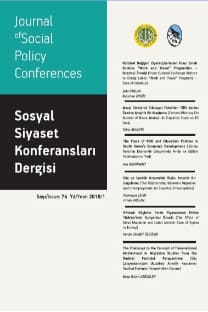DAYTON ANLAŞMASI SONRASINDA BOSNA’DA POLİTİK İSTİKRAR VE EKONOMİK PERFORMANS (1997-2006)
Bu makale, Dayton anlaşması sonrasında Bosna’nın politik sisteminin politik istikrarı ve ekonomik performansını Birleşmiş Milleler Kalkınma Programı ve Bosna devlet kurumlarının verilerine dayalı olarak incelemektedir. Çalışmada, bu ülkede toplumun temel yasama ve yürütme organlarının işleyişine olan güveninin görece olarak düşük olduğunu ve bu güvenin etnik gruplar arasında farklılık gösterdiğini iddia etmektedir. Ayrıca, seçilmiş temsilcilerin politik açıdan uzlaşmadıklarını ve bu yüzden ülkeyi politik istikrasızlığın karakterize ettiğini ileri sürülmektedir. Ancak aynı zamanda ülkeyi askeri çatışmadan kurtaran uluslararası kurumların varlığının bu ülkeye ileri düzeyde bir politik istikrar kazandırdığı ifade edilmektedir.
Anahtar Kelimeler:
Bosna ve Hersek, Dayton Barış Antlaşması, politikistikrar, kurumsal istikrar, ekonomik performans, politik güven
POLITICAL STABILITY AND ECONOMIC PERFORMANCE IN THE POST-DAYTON BOSNIA, 1997-2006
This paper examines political stability and economic performance of the Bosnian political system in the post-Dayton period and is primarily based on statistical figures released by the United Nations Development Program (UNDP) and state institutions. Study shows that people’s confidence in the work of the main legislative and executive institutions in the country is relatively low and that their confidence varies from one ethnic group to another. Furthermore, political attitudes of the elected representatives were non-conciliatory and, therefore the country was characterized by constant institutional instability. At the same time, the country enjoyed a high level of political stability, however, only due to the huge presence of the international community, which secured the country from the escalation of political representatives’ disagreements into military confrontation.
Keywords:
Bosnia and Herzegovina Dayton Peace agreement, political stability, institutional instability, , economic performance, political confidence.,
___
- Ashdown Paddy, “Leaving the Work Unfinished,” International Herald Tribune (April 4, 2007);
- Ashdown Paddy, “Don’t Declare ‘Mission Accomplished’ in Bosnia Yet”, The Independent (March 30, 2007).
- Bosnia and Herzegovina: The 2004 Economic Report, 7 and 47-49. available at: http://www.eppu.ba/pdf/Economic_report_2004_2406_English.pdf.
- Carevic Mico, “Dayton Çhallenges: Dream about Secession,” Aimpress (March 22, 1997), available at: http://www.aimpress.ch/dyn/trae/archive/ data/199703/70322-004-trae-sar.htm.
- Central Bank of Bosnia and Herzegovina, Annual Report, 2005.
- Donais Timothy and Pickel Andreas, “The International Engineering of a Multiethnic State in Bosnia: Bound to Fail, Yet Likely to Persist,” (Unpublished paper), available at http://www.trentu.ca/org/tipec/ 3donaispickel2.pdf.
- Interview with Nikola Spiric, Chairman of the Council of Ministers of Bosnia on Radio and Television of Bosnia and Herzegovina (RTVBiH), April 3, 2007 (private archive).
- Interview with Dirk Reinermann, Head of the World Bank mission in Bosnia, May 14, 2005. available at: www.worldbank.org.ba
- Habul Emir, “Cutting the Lizard’s Tail”, AIM Sarajevo (December 3, 1999). available at: http://www.aimpress.ch/dyn/trae/archive/data/199912/ 91291-005-trae-sar.htm
- Official Gazette of Bosnia and Herzegovina, No. 19/01 (August 3, 2001).
- Office of the High Representative, Peace Implementation Bonn Conclusions. available at: http://www.ohr.int/pic/default.asp?content_id=5182
- Office of the High Representative Bulletin, No. 25 (November 15, 1996), available at: http://www.ohr.int/ohrdept/presso/chronology/bulletins/ default.asp?content_id=4950.
- Pecanin Senad, Lovrenovic Ivan, Curak Nezuk and Stojic Mile, “Deset teza za Bosnu i Hercegovinu,” Dani, No. 139 (January 28, 2000), available at: http://www.bhdani.com/arhiva/139/t391.htm.
- Petritsch Wolfgang, “Ovo nije nasa zemlja,” Dani, No. 144 (March 3, 2000), available at: http://www.bhdani.com/arhiva/144/t447.htm.
- Silajdzic Haris, “Memorandum on change: The Dayton Peace Accord- A Treaty that is not Being Implemented,” Bosnia Report, The Bosnian Institute, No. 13/14 http://www.bosnia.org.uk/bosrep/decfeb00/dayton.cfm 2000), 2, available at:
- United Nations Development Program, Early Warning System Research, Special Edition 2000-2006.
- ISSN: 1304-0103
- Yayın Aralığı: Yılda 2 Sayı
- Başlangıç: 1948
- Yayıncı: İstanbul Üniversitesi Yayınevi
Sayıdaki Diğer Makaleler
Anayasa Değişikliği ve Çalışma Yaşamına Yansımaları-Açılış Konuşmaları
ESNEKLİK KAVRAMI ve EMEK PİYASALARINDA ESNEKLİK
DAYTON ANLAŞMASI SONRASINDA BOSNA’DA POLİTİK İSTİKRAR VE EKONOMİK PERFORMANS (1997-2006)
ENFLASYON HEDEFLEMESİ, MAKROEKONOMİK İSTİKRAR VE TÜRKİYE
BATI ANADOLU'DA İHRACAT İÇİN PAMUK ÜRETİMİ (1860-1870)
Anayasa Değişikliği ve Çalışma Yaşamına Yansımaları-PANEL
Ali SAYIN, Ahmet GÜNDOĞDU, Bircan AKYILDIZ, Bülent PİRLER, Nejdet OKCAN, Semih TEMİZ
Anayasa Değişikliği ve Çalışma Yaşamına Yansımaları-Açılış Konferansı
Anayasa Değişikliği ve Çalışma Yaşamına Yansımaları-İç Kapak
